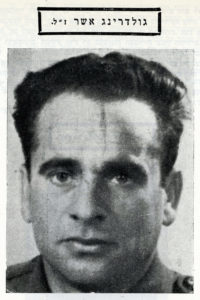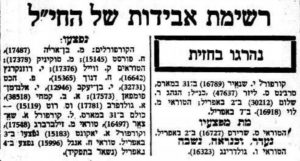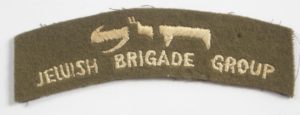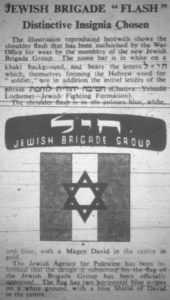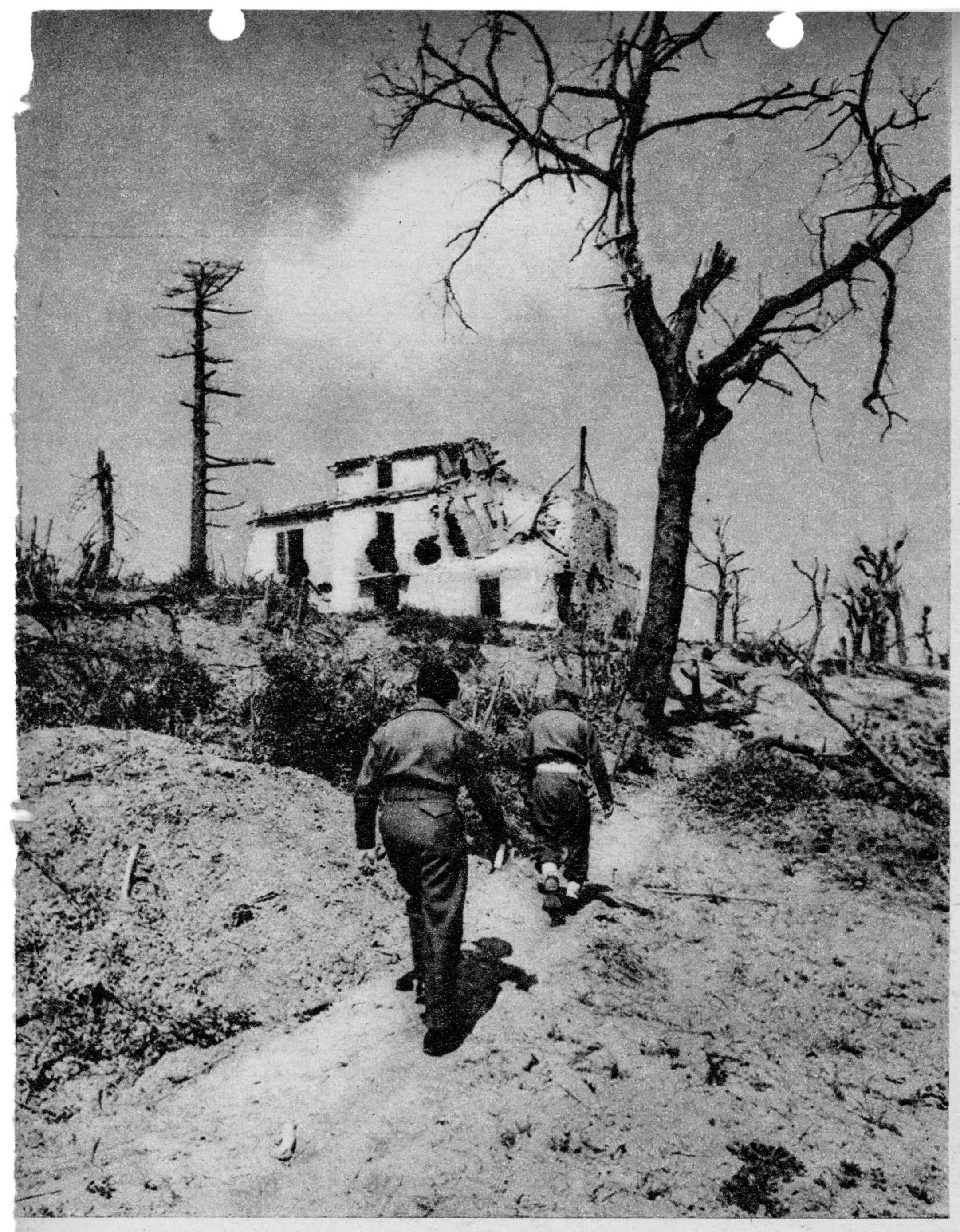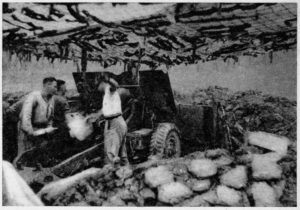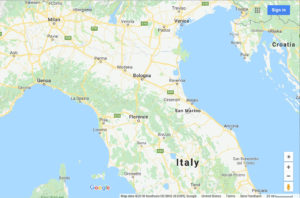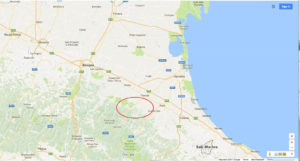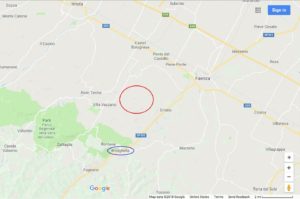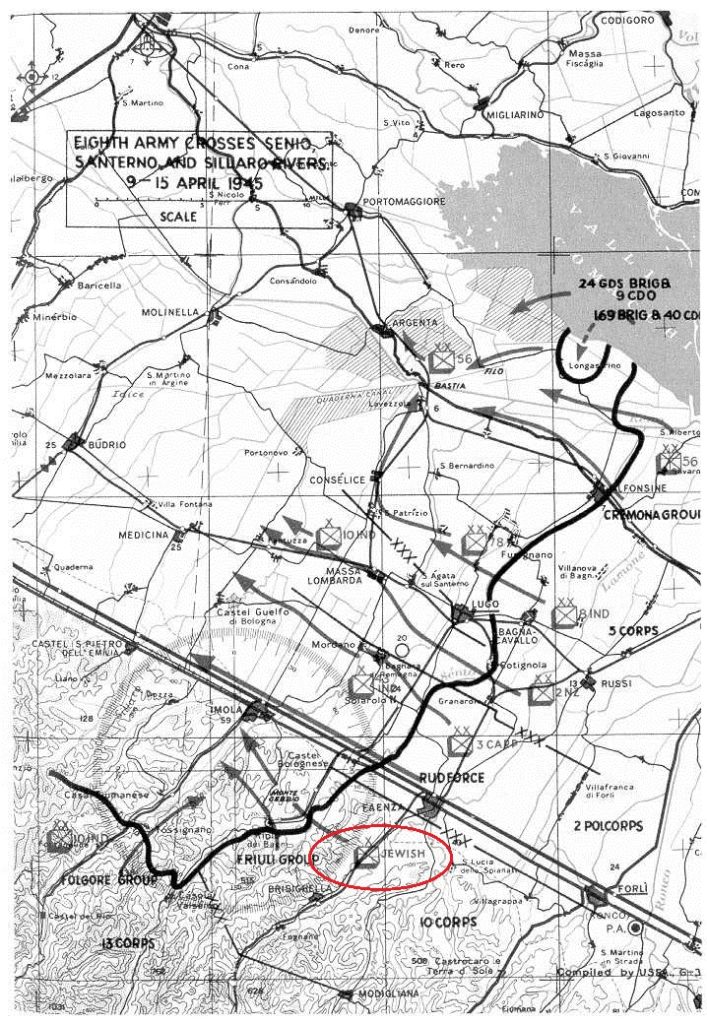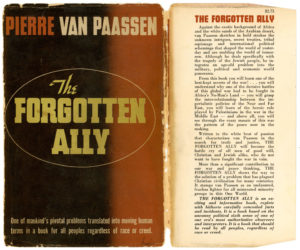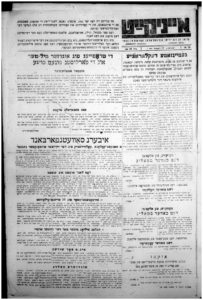This post marks a return to an ongoing theme (one of several) at this blog: A survey of Jewish military service during the Second World War, based upon obituaries for Second World War Jewish military casualties from the New York Metropolitan area, which appeared in The New York Times, particularly during 1945.
Given the demographic characteristics of American Jews during the mid-twentieth century, it was perhaps inevitable that a vast amount of information about the military service of American Jews during that war would be presented in the Times. Yet, given the ideology and identity – such as it was, is, and continues to be – of the owners and editors of the Times regarding the perception of the Jewish people as a people – an ethnos – the subject of a vast amount of academic and popular literature, the most outstanding example being Laurel Leff’s Buried By The Times, virtually no Second World War era news item in the Times touching upon the military service of Jewish soldiers, ever placed the latter within the larger context of the collective survival of the Jewish people. (Well, truth be told, one did, in language as tangential as it was guarded. But, that will be the subject of a future post.)
Given the tenor of the times and the nature of the Times – and by any stretch of the imagination not only the Times! – it would probably have been futile to have expected otherwise.
So… Having thus far covered surnames commencing with the letters “A” though “H”, this post is centered upon Private First Class Warren W. Jacobs of the United States Army Air Force, whose death was reported upon in the Times on May 31, 1945.
Notably, given that there is no Missing Air Crew Report pertaining to him, information about the circumstances of his death is probably limited to the historical records of the 11th Bomb Squadron.
Bronx Radio Operator Killed on China Flight
May 31, 1945
Pfc. Warren W. Jacobs, son of Mr. and Mrs. Dave Jacobs of 1694 Clay Avenue, the Bronx, was killed in action over China on May 22, his parents have been notified. A member of the Eleventh Combat Squadron of the Tenth Air Force, he had 725 flying hours to his credit.
Private Jacobs, 24 years old, had received the Distinguished Flying Cross with two Oak Leaf clusters and the Air Medal with three clusters. He was a radio operator in a B-29 [sic].
The soldier was a graduate of DeWitt Clinton High School and left Long Island University to join the armed forces. He was studying to be an engineer. In addition to his parents he is survived by a sister, Mrs. Edward Flegler of Yonkers.
 Warren Jacobs’ portrait in the Times.
Warren Jacobs’ portrait in the Times.
__________________________
 Contemporary view of 1694 Clay Ave., the Bronx, the wartime residence of the Jacobs family.
Contemporary view of 1694 Clay Ave., the Bronx, the wartime residence of the Jacobs family.
__________________________
Jacobs, Warren W. (Zeev bar David), PFC, 32425076, Radio Operator, Distinguished Flying Cross, Air Medal, 5 Oak Leaf Clusters, Purple Heart
United States Army Air Force, 10th Air Force, 341st Bomb Group, 11th Bomb Squadron
Born 5/2/21
Mr. Dave Jacobs (father), 1694 Clay Ave., Bronx, N.Y.
Mrs. Edward Fliegler (sister), Yonkers, N.Y.
No Missing Air Crew Report; Circumstances unknown
Bayside Cemetery, Ozone Park, N.Y.
Casualty List 5/31/45
The New York Times (Obituary Section) 5/22/46, 5/22/48
American Jews in World War II – 351
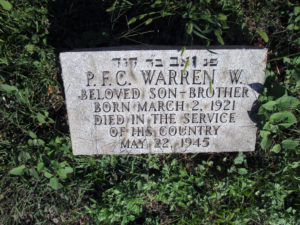 Matzeva of PFC Jacobs (Zeev bar David), from FindAGrave contributor ntatap.
Matzeva of PFC Jacobs (Zeev bar David), from FindAGrave contributor ntatap.
__________________________
______________________________
Other Jewish military casualties on May 22, 1945 (10 Sivan 5705), include the following…
Killed in Action
– .ת. נ. צ. ב. ה –
תהא
נפשו
צרורה
בצרור
החיים
United States Army Air Force
The end of the war in Europe did not mean the end of the war. S/Sgt. Leonard Orloff and T/Sgt. Marvin Schaefer, both members of the Pacific-based 5th Air Force of the United States Army Air Force, were lost during combat missions in Pacific Theater, albeit not immediately and specifically due to enemy action.
As recorded in John Alcorn’s The Jolly Rogers, “The heavy operational schedule was plagued by a distressing series of losses. …a similar tragedy occurred when the 319th B-24L of Lt. Roy E. Hurd failed to gain altitude after takeoff from Mindoro. The right wing was seen to hit the water, and the stricken craft burst into flames as it smashed into the water. Two injured crewmen survived, [2 Lt.] Lt. Hershell Miller [0-700513], the co-pilot, and T/Sgt. Lawrence Cote [11070352], the radio operator.”
And, as recorded in the diary of 90th Bomb Group pilot Lt. Merle B. Winne, “22 May 1945 Today we were assigned to go to Kiirun Formosa carrying 5- 1000 lb. Demos. Due to weather however, we could not reach the target. We used our second alternate of military barracks and installations at Toshien Formosa. Due to a C-1 failure in our lead ship, we had to make two runs over the target getting very light flak both times. We flew #3 in the #3 squadron. Joe flew the run. On take off here at the field before daylight, Lt. Hurd and his crew crashed into the sea just off the end of the runway. The Co-pilot and one gunner were saved after the ship exploded. The Co-pilot was unscratched but the gunner had a broken back. I was pallbearer today for the three bodies that were recovered.”
Orloff, Leonard R., S/Sgt., 33789646, Gunner, Air Medal, Purple Heart
90th Bomb Group, 319th Bomb Squadron
Born 1921
Mr. and Mrs. Aaron [?-1/11/41] and Rose [1895-5/6/68] Orloff (parents), 2138 Arch St., Philadelphia, Pa.
Mr. Albert P. Orloff (brother), 710 Brown St., Philadelphia, Pa.
MACR 15378, Aircraft B-24L 44-41552, Pilot 1 Lt. Roy E. Hurd, 10 crew members – 2 survivors
Golden Gate National Cemetery, San Bruno, Ca. – Section B, Grave 373; Buried 11/3/48
Philadelphia Inquirer 6/16/45
Philadelphia Bulletin 6/16/45
American Jews in World War II – 542
Born in 1917, Hershell L. Miller died in 1972, and is buried at Fort Logan National Cemetery, in Denver. Born in 1922, Lawrence R. Cote died in 1993 and is buried at Atascadero, California.
______________________________
The crew roster for B-24 44-41552 and information about the aircraft’s loss on the mission of May 22, 1945, appear in this “first” page of MACR 15378.
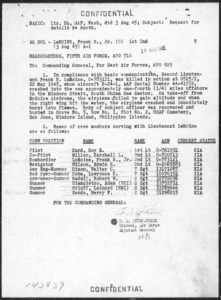 ______________________________
______________________________
The Philippine archipelago. San Jose Airfield, then the base of the 90th Bomb Group, is located at the southern tip of Mindoro Island, which is located just to the left of the center of this (Goggle) map view.
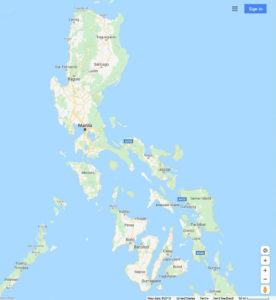 ______________________________
______________________________
A large-scale view of the location of San Jose Airfield (now San Jose Airport)…
 ______________________________
______________________________
…and, an equivalently oriented satellite view of the above map, with the single runway of San Jose Airfield (now San Jose Airport) readily visible in the center of the image.
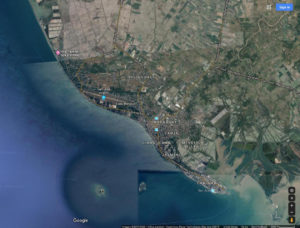 ______________________________
______________________________
Akin to Private Jacobs, no Missing Air Crew Report actually exists for the loss of T/Sgt. Schaefer’s aircraft, albeit like many airmen, an index card was filed in his name and incorporated within the MACR name card index.
Information about the incident instead comes from a variety of links at the website of The Flying Circus – the 380th Bomb Group. By consulting the Group’s abbreviated roster of personnel and list of aircraft by serial numbers, his plane was identified as B-24L 44-42487. Piloted by Harry B. Trimble, the bomber was abandoned 35 miles off coast of Mindoro, in the Philippine archipelago, after a strike against Kiirun Stores on Formosa. The crew’s bombardier – 2 Lt. Ralph J. Walsh, from Denver, Colorado – was also killed (buried at Manila American Cemetery, Fort Bonifacio, Manila, Philippines), while the other crew members were presumably rescued and survived.
Schaefer, Marvin, T/Sgt., 15133790, Flight Engineer, Air Medal, 2 Oak Leaf Clusters, Purple Heart, 35 missions
380th Bomb Group, 529th Bomb Squadron
Born 1921
Mr. and Mrs. Harry N. [?-8/16/66] and Sophia [?-2/9/87] Schaefer (parents), 17725 Crestland Road, Cleveland, Oh.
Capt. Leonard Schaefer and Ruth Jean Schaefer (brother and sister)
Tablets of the Missing at Manila American Cemetery, Manila, Philippines
Cleveland Press & Plain Dealer, June 14 & 15, 1945
American Jews in World War II – 498
Though the actual composition of Schaefer’s crew is uncertain, based on records at the Flying Circus website, the men p r o b a b l y were:
Definite crew members
Trimble, Harry B., Pilot / Aircraft Commander, 0-421379 (also in Harry E. Rollings, Jr.’s, Crew)
Walsh, Ralph Joseph, 2 Lt., Bombardier, 0-696289 (also in Henry H. Day’s Crew)
Probable crew members
Steil, Robert J., Pilot / Aircraft Commander, T-764600 / 0-2024055
Lowell, Joseph F., Navigator, 0-807261
Richards, George W., III, Flight Engineer, 13107493
Rinoldo, Anthony C., Flight Engineer, 32934641
Warzecha, Stanley J., Gunner, 36861232
Smart, George J., Gunner, 36308822
Fox, George W., 15118322, Gunner / Photographer (also in other crews)
Possible crew member
Melton, Thomas I., Bombardier, 0-731176
______________________________

An in-flight view of the actual aircraft flown by the Trimble crew on May 22, 1945 (though the date of the image is unknown): Un-nicknamed B-24L 44-42487, from the Robert Chandler collection.
______________________________
Casualties in other theaters of war
Cohen, Ephraim, Driver, T/183391, Mentioned in Despatches, Gazette 7/19/45
England, Royal Army Service Corps
Born 1917
Mr. P. Cohen (father), Newcastle-on-Tyne, England
Died on active service
Udine War Cemetery, Udine, Italy – III,B,1
The Jewish Chronicle 7/13/45
We Will Remember Them – A Record of the Jews Who Died in the Armed Forces of the Crown 1939 – 1945 – 74
We Will Remember Them – A Record of the Jews Who Died in the Armed Forces of the Crown 1939 – 1945 – An Addendum – 61
Gash, Robert W., PFC, 36219819, Purple Heart, in Luzon, Philippines
United States Army, 40th Infantry Division, 160th Infantry Regiment, Headquarters Company, 1st Battalion
Born 9/27/19
Mrs. Rose W. Gash (mother), 1812 East Belleview Place, Milwaukee, Wi.
Temple Menorah Ever-Rest Cemetery, Milwaukee, Wi. – SEBA,L13,G6
American Jews in World War II – 584
Greenberg, Jerome H., Sgt., 36579605
United States Army, 106th Infantry Division, 424th Infantry Regiment
Non-Battle, in Germany
Born 1918
Mrs. Anne R. Greenberg (wife), 9360 Genesee St., Detroit, Mi.
Mr. Herman H. Greenberg (father)
Graduate of Detroit College of Law
Machpelah Cemetery, Ferndale, Mi. – Section Z, Lot 15, Grave 439D; Buried 1/5/49
WW II Honoree page by Mrs. Anne Radner, daughter
The Jewish News (Detroit) 6/8/45
American Jews in World War II – 191
 Photograph of Sergeant Greenberg at the WW II Honoree page created by his daughter, Anna Radner
Photograph of Sergeant Greenberg at the WW II Honoree page created by his daughter, Anna Radner
______________________________
Koslovitz, Mattathiahu, Cpl., PAL/17467
Yishuv, Jewish Brigade Group, Palestine Regiment, 1st Battalion
Caserta War Cemetery, Italy – V,B,14
Name in Commonwealth War Graves Commission database is “Kozlowicz, M.”
We Will Remember Them – A Record of the Jews Who Died in the Armed Forces of the Crown 1939 – 1945 – 249 (as “Koslovitz, Mattathiahu”)
The Book of the Jewish Brigade: The History of the Jewish Brigade Fighting and Rescuing [in] the Diaspora (Sefer ha-Brigadah ha-Yehudit: ḳorot ha-ḥaṭivah ha-Yehudit ha-loḥemet ṿeha-matsilah et ha-golah ((גולהה קורות החטיבה היהודית הלוחמת והמצילה אתספר הבריגדה היהודית)) – 292
Portrait of Corporal Koslovitz from The Book of the Jewish Brigade: The History of the Jewish Brigade Fighting and Rescuing [in] the Diaspora
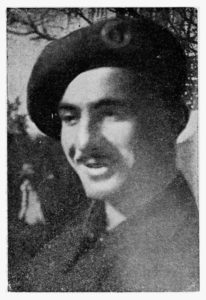 Biography, in Hebrew, of Corporal Koslovitz in The Book of the Jewish Brigade: The History of the Jewish Brigade Fighting and Rescuing [in] the Diaspora
Biography, in Hebrew, of Corporal Koslovitz in The Book of the Jewish Brigade: The History of the Jewish Brigade Fighting and Rescuing [in] the Diaspora
 Translation of the above…
Translation of the above…
Corporal Koslovitz Mattathiahu – God rest his soul
Died on 6th of Sivan 22.5.1945
He was hit in the chest by a shell as his regiment (the First Regiment) passed the Senio River. His wound seemed slight: he was moved from one military hospital to another, recovered, and managed to walk. But when he underwent surgery on 22.5.1945, he died suddenly during the operation.
He came to Israel as a child. He went to elementary school and later to the “Max Fine” professional school and was also occupied in youth jobs. He enlisted into the No. 20 infantry unit and like thousands of his comrades, tolerated inaction and guard duty. When the Jewish Brigade was formed, and especially during the training period in Fuji [sic] he was happy and proud of himself. He would say: “we have a real army”. He was promoted to the rank of Corporal at the front line for his dedication and diligence.
Even as a child he was diligent and loved working, and was also loyal and dedicated to his friends and ideals. He was loved by his friends in his platoon for his kindness, good spirit, cheerfulness, friendly attitude and willingness to help. At the front line he demonstrated courage and willingness to do any job. In the many letters he sent to his friends from the hospitals he was in, he expressed his desire to go back to the front lines.
______________________________
Miedzinski, Hersz, Pvt. (Germany, Saxony, Forstgen (During Operation Brand Berlin)) (Died of wounds?)
Poland, Polish People’s Army, 5th Infantry Division
Born Ukraine, Zloczow (d. Tarnopol); 9/28/18
Mr. Majer Miedzinski (father)
Place of burial unknown
Jewish Military Casualties in the Polish Armies in World War II: I – Jewish Soldiers and Officers of the Polish People’s Army Killed and Missing in Action 1943-1945 – 49
Sierczyk, Daniel, Sergeant Major (Poland, Janow), Died of wounds
Poland, Polish People’s Army, Infantry Officer’s School
Born Chelm, Lubelskie, Poland, 5/16/25
Mr. Jakub Sierczyk (father)
Biala Street Community Cemetery, Lublin, Poland
Jewish Military Casualties in the Polish Armies in World War II: IV – Jewish Officers, Prisoners-of-War, Murdered in Katyn Crime; Jewish Military Casualties in the Polish Resistance Movement, An Addendum – 103
Yonis, Ralph (Rafael bar Rachmim), Pvt., 11131585, Purple Heart, in Mindanao, Philippines
United States Army, 24th Infantry Division, 21st Infantry Regiment
Born 1926
Mr. and Mrs. Rachamim [8/9/90-10/11/63] and Sophie (Pappos) [5/15/00-10/15/60] Yonis (parents), 133 Main St., Peabody, Ma.
John, Samuel, and Sara (brothers and sister)
Buried at Sons of Jacob Cemetery, Danvers, Ma.
Casualty List 6/26/45
American Jews in World War II – 185
 Matzeva of Private Yonis, from FindAGrave contributor Pamela Filbotte-Hollabaugh
Matzeva of Private Yonis, from FindAGrave contributor Pamela Filbotte-Hollabaugh
______________________________
Wounded in Action
Epstein, Albert, Pvt., Purple Heart, in Luzon, Philippines
United States Army
Born 1926
Mr. Michael Epstein (father), 103 Durfor St., Philadelphia, Pa.
The Jewish Exponent 7/6/45
Philadelphia Bulletin 6/26/45
Philadelphia Record 6/26/45
American Jews in World War II – 519
Rubin, Irving Thomas, PFC, 896700, Purple Heart
United States Marine Corps, 6th Marine Division, 4th Marine Regiment, 1st Battalion, B Company
Born 1918
Mrs. Lydia B. Rubin (wife), 283 Beach St. (or) 94 Walnut Ave., Revere, Ma.
American Jews in World War II – 177
Silver, Solomon Saul, PFC, 502669, Purple Heart
United States Marine Corps, 1st Marine Division, 1st Marine Regiment, 1st Battalion, C Company
Mr. Abraham Silver (father), 471 Neptune Ave., Brooklyn, N.Y.
Mrs. Thelma S. Brown (sister)
WW II Memorial Honoree Page
Casualty List 7/13/45
American Jews in World War II – 443
References
Alcorn, John S., The Jolly Rogers – History of the 90th Bomb Group During World War II, Historical Aviation Album, Temple City, Ca., 1981
Dublin, Louis I., and Kohs, Samuel C., American Jews in World War II – The Story of 550,000 Fighters for Freedom, The Dial Press, New York, N.Y., 1947
Lifshitz, Jacob (יעקב, ליפשיץ), The Book of the Jewish Brigade: The History of the Jewish Brigade Fighting and Rescuing [in] the Diaspora (Sefer ha-Brigadah ha-Yehudit: ḳorot ha-ḥaṭivah ha-Yehudit ha-loḥemet ṿeha-matsilah et ha–golah ((גולהה קורות החטיבה היהודית הלוחמת והמצילה אתספר הבריגדה היהודית)), Shim’oni (שמעוני), Tel-Aviv, 1950
Meirtchak, Benjamin, Jewish Military Casualties in the Polish Armies in World War II: I – Jewish Soldiers and Officers of the Polish People’s Army Killed and Missing in Action 1943-1945, World Federation of Jewish Fighters Partisans and Camp Inmates: Association of Jewish War Veterans of the Polish Armies in Israel, Tel Aviv, Israel, 1994
Meirtchak, Benjamin, Jewish Military Casualties in the Polish Armies in World War II: IV – Jewish Officers, Prisoners-of-War, Murdered in Katyn Crime; Jewish Military Casualties in the Polish Resistance Movement; An Addendum, World Federation of Jewish Fighters Partisans and Camp Inmates: Association of Jewish War Veterans of the Polish Armies in Israel, Tel Aviv, Israel, 1997
Morris, Henry, Edited by Gerald Smith, We Will Remember Them – A Record of the Jews Who Died in the Armed Forces of the Crown 1939 – 1945, Brassey’s, United Kingdom, London, 1989
Morris, Henry, Edited by Hilary Halter, We Will Remember Them – A Record of the Jews Who Died in the Armed Forces of the Crown 1939 – 1945 – An Addendum, AJEX, United Kingdom, London, 1994
McGuire Airdrome / McGuire Airfield (San Jose Airport), at Pacific Wrecks
1 Lt. Roy E Hurd, at FindAGrave
Diary of Merle B. Winne, at 90th Bomb Group
Plus, special thanks to Ari for help with the Hebrew-to-English translation.



